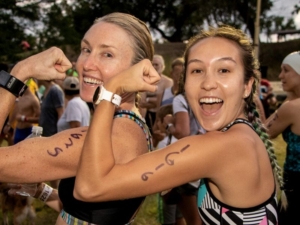Keep logging those miles with these motivational running tips
Whether you’re a seasoned runner or a first-timer you will face a time when you’re feeling too “blah” to run. Perhaps you’re too busy, too tired, or maybe feeling under the weather. You’re not alone! This is something that all triathletes experience. Breakthrough the excuse barrier with these 6 motivational running tips. It’ll keep your offseason training on track and you’ll be ready for the upcoming season.
 Pro tip: always take time off from running to recover if you’re injured or sick. Most importantly, you should always listen to your body! Here are more helpful tips if you’ve started training for a triathlon.
Pro tip: always take time off from running to recover if you’re injured or sick. Most importantly, you should always listen to your body! Here are more helpful tips if you’ve started training for a triathlon.
-
Call Your Running Partner
Having a running partner gives you the accountability factor. Running with another person is always fun because you can challenge each other. On days when you need a nudge, they can “talk” you into at least putting your running gear on and joining them for a few easy miles.
-
Set a Shorter Running Goal
If you run 5K every day, reduce it to 2K on days where you’re not feeling it. You will trick your mind into believing that the run will be over soon. Chances are though, once you’re out there running, you’ll likely hit the 5K mark.
-
Update Your Tunes
If you like to run while listening to music, maybe changing up the tunes will help. Sometimes we get bored listening to the same tunes, which can affect your passion for running. Choose “feel good” songs that inspire you, especially on gloomy days.
-
Slow Down
Walking is an excellent alternative for getting fit. It’s okay if you’re not in the mood to run. Go for a brisk walk. This will get your heart pumping. It’s possible you might start jogging once you’re there!
-
Revisit Your Goals
This is another form of self-accountability. If you are truly feeling a lack of inspiration towards running, take some time out and examine your fitness goals. What is it you want to achieve? Do you want to lose weight? Do you want to improve your cardiovascular fitness? Remind yourself about these goals and how meeting them will benefit you. Pro tip: these 10 mood-boosting quotes can help too!
-
Change Your Route
Do you run the same route every day? Perhaps changing the course will stimulate your curiosity and inspire you to run. You’ll learn new routes, work muscles differently, and explore new sections of your city or neighborhood.
Keep in mind, it’s perfectly normal to not feel like running on a daily basis. Proper rest and recovery is just as important for your body as a short run. Give one of these 6 motivational running tips a try the next time you don’t feel like running. You’ll be glad you got out there when you finish!





 Making memories
Making memories
 Cycling. Cycling is built for fueling. You have bottle cages on your bike, the right choice in your race clothing will have pockets for holding gels and other forms of nutrition. There are also tons of other equipment you can add to your bike to pretty much carry as much as you want. One key is to use the
Cycling. Cycling is built for fueling. You have bottle cages on your bike, the right choice in your race clothing will have pockets for holding gels and other forms of nutrition. There are also tons of other equipment you can add to your bike to pretty much carry as much as you want. One key is to use the 













 Howard Edward Butt Sr. was son to Florence Thornton Butt and pharmacist, Charles Butt, who relocated to Kerrville, Texas in 1905 for the drier climate to combat his father’s tuberculosis. Florence opened a small grocery store below their apartment as a place for locals to get their groceries. Once Howard was in high school, he took over the store as a manager. After a brief stint in the Navy, Howard returned home to run the store with his mother. Although his first attempts at expanding the family business failed, he achieved success when he opened a store in Del Rio, Texas. In 1935, he changed the name of the company to H.E. Butt Grocery which was eventually shortened to, you guessed it,
Howard Edward Butt Sr. was son to Florence Thornton Butt and pharmacist, Charles Butt, who relocated to Kerrville, Texas in 1905 for the drier climate to combat his father’s tuberculosis. Florence opened a small grocery store below their apartment as a place for locals to get their groceries. Once Howard was in high school, he took over the store as a manager. After a brief stint in the Navy, Howard returned home to run the store with his mother. Although his first attempts at expanding the family business failed, he achieved success when he opened a store in Del Rio, Texas. In 1935, he changed the name of the company to H.E. Butt Grocery which was eventually shortened to, you guessed it, 